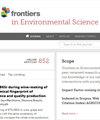Analysis of the evolution of watershed habitat quality and its drivers under the influence of the human footprint
IF 3.3
3区 环境科学与生态学
Q2 ENVIRONMENTAL SCIENCES
引用次数: 0
Abstract
Habitat quality (HQ) serves as a pivotal metric for assessing biodiversity and ecosystem health, with alterations in land use driven by human activities posing direct implications on HQ and ecological sustainability within river basins. Prior research on HQ has predominantly centered on historical land use changes, neglecting the comprehensive consideration of future land use transformations and ecological zoning strategies’ influence on HQ. Consequently, this investigation simulates potential land use shifts in the Min River Basin across various future scenarios, leveraging the integration of PLUS and InVEST models, quantitatively dissects HQ’s responsiveness to these changes and delves into the spatial differentiation dynamics underlying these responses, while also exploring the drivers behind such differentiation. Synergizing with the Human Footprint Index (HFI), the study devises a rational ecological zoning plan tailored to the region and outlines targeted control measures for each zone. The results of the study showed that: 1) the east-central part of the Min River Basin was subject to a greater degree of human interference, and the trend of interconversion between grassland, forest land, and cropland was relatively significant, with construction land mainly originating from the transfer of cropland; 2) from 2000 to 2020, average HQ scores for priority protected zones, priority recovery zones, and appropriate development zones stood at 0.9372, 0.2697, and 0.6098, respectively, accompanied by a rise in the proportion of low and moderate HQ areas to 15% and 17%; (3) DEM and Slope were the main drivers affecting HQ, and their explanatory power reached 0.519 and 0.426, respectively; (4) in comparison to a natural development scenario (ND), the planning protection scenario (PP) offers greater promise for ecological preservation and sustainable development within the Min River Basin. The research results can provide technical support for the ecological restoration of land resources and the development and protection of national land space in watershed areas.分析人类足迹影响下流域生境质量的演变及其驱动因素
栖息地质量(HQ)是评估生物多样性和生态系统健康的关键指标,人类活动导致的土地利用变化直接影响到流域内的栖息地质量和生态可持续性。以往关于生境质量的研究主要集中于历史上土地利用的变化,忽视了未来土地利用转型和生态分区策略对生境质量影响的综合考虑。因此,本研究通过整合 PLUS 和 InVEST 模型,模拟岷江流域在各种未来情景下可能发生的土地利用变化,定量分析 HQ 对这些变化的响应,并深入研究这些响应背后的空间分异动态,同时探索这种分异背后的驱动因素。通过与人类足迹指数(HFI)的协同作用,该研究为该地区量身定制了合理的生态分区规划,并为每个分区列出了有针对性的控制措施。研究结果表明1)闽江流域东中部受人为干扰程度较高,草地、林地、耕地相互转化趋势较明显,建设用地主要来源于耕地流转;2)2000-2020 年,优先保护区、优先恢复区和适度开发区的 HQ 平均值分别为 0.9372、0.2697和0.6098,低度和中度HQ区的比例分别上升到15%和17%;(3)DEM和坡度是影响HQ的主要驱动因素,其解释力分别达到0.519和0.426;(4)与自然发展情景(ND)相比,规划保护情景(PP)为岷江流域的生态保护和可持续发展带来了更大的希望。研究成果可为流域土地资源生态修复、国土空间开发与保护提供技术支撑。
本文章由计算机程序翻译,如有差异,请以英文原文为准。
求助全文
约1分钟内获得全文
求助全文
来源期刊

Frontiers in Environmental Science
Environmental Science-General Environmental Science
CiteScore
4.50
自引率
8.70%
发文量
2276
审稿时长
12 weeks
期刊介绍:
Our natural world is experiencing a state of rapid change unprecedented in the presence of humans. The changes affect virtually all physical, chemical and biological systems on Earth. The interaction of these systems leads to tipping points, feedbacks and amplification of effects. In virtually all cases, the causes of environmental change can be traced to human activity through either direct interventions as a consequence of pollution, or through global warming from greenhouse case emissions. Well-formulated and internationally-relevant policies to mitigate the change, or adapt to the consequences, that will ensure our ability to thrive in the coming decades are badly needed. Without proper understanding of the processes involved, and deep understanding of the likely impacts of bad decisions or inaction, the security of food, water and energy is a risk. Left unchecked shortages of these basic commodities will lead to migration, global geopolitical tension and conflict. This represents the major challenge of our time. We are the first generation to appreciate the problem and we will be judged in future by our ability to determine and take the action necessary. Appropriate knowledge of the condition of our natural world, appreciation of the changes occurring, and predictions of how the future will develop are requisite to the definition and implementation of solutions.
Frontiers in Environmental Science publishes research at the cutting edge of knowledge of our natural world and its various intersections with society. It bridges between the identification and measurement of change, comprehension of the processes responsible, and the measures needed to reduce their impact. Its aim is to assist the formulation of policies, by offering sound scientific evidence on environmental science, that will lead to a more inhabitable and sustainable world for the generations to come.
 求助内容:
求助内容: 应助结果提醒方式:
应助结果提醒方式:


